
The Asclepiadoideae are a subfamily of plants in the family Apocynaceae. Formerly, they were treated as a separate family under the name Asclepiadaceae, e.g. by APG II, and known as the milkweed family.
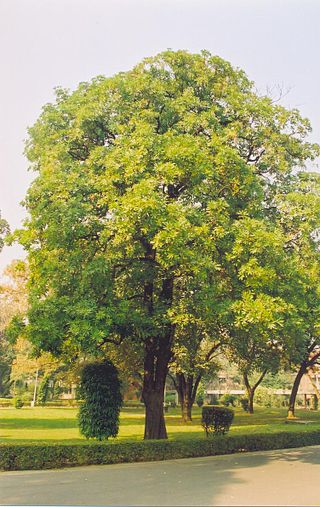
Alstonia is a widespread genus of evergreen trees and shrubs, of the family Apocynaceae. It was named by Robert Brown in 1811, after Charles Alston (1685–1760), professor of botany at Edinburgh from 1716 to 1760.
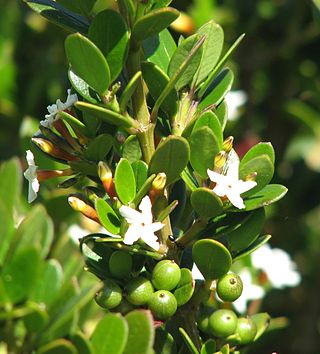
Alyxia is an Australasian genus of flowering plant in the dogbane family, Apocynaceae. It contains at present 106 species, but Alyxia stellata and A. tisserantii are very variable, might be cryptic species complexes, and are need of further study. It consists of shrubby, climbing or scrambling plants. This genus occurs in China, the Himalayas, Southeast Asia, Australia, New Caledonia and the Pacific Islands. There are 14 species in Australia, 21 in New Caledonia and 7 in the other Pacific Islands, including Hawaiʻi.

Cerbera is a genus of evergreen trees or shrubs, native to tropical Asia, Australia, Madagascar, and various islands in the Indian and Pacific Oceans.
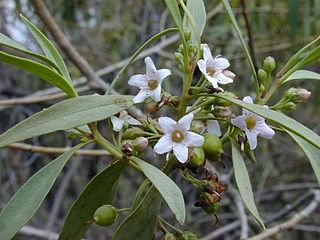
Myoporum is a genus of flowering plants in the figwort family, Scrophulariaceae. There are 30 species in the genus, eighteen of which are endemic to Australia although others are endemic to Pacific Islands, including New Zealand, and one is endemic to two Indian Ocean islands. They are shrubs or small trees with leaves that are arranged alternately and have white, occasionally pink flowers and a fruit that is a drupe.

Fontainea is a genus constituting part of the plant family Euphorbiaceae. The nine currently known species grow naturally in Queensland (Qld) and New South Wales (NSW) Australia, New Caledonia and Vanuatu, and Papua New Guinea. Some species are commonly named blushwood.

The genus Tacca, which includes the batflowers and arrowroot, consists of flowering plants in the order Dioscoreales, native to tropical regions of South America, Africa, Australia, Southeast Asia, and various Oceanic islands. In older texts, the genus was treated in its own family Taccaceae, but the 2003 APG II system incorporates it into the family Dioscoreaceae. The APG III and APG IV systems continue to include Tacca in Dioscoreaceae.
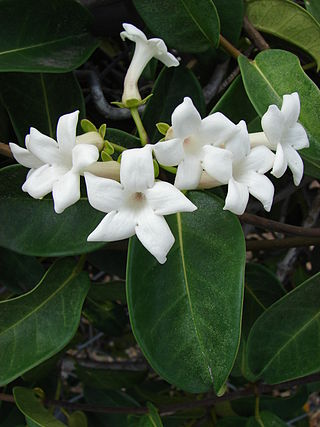
Marsdenia is a genus of plants in the family Apocynaceae first described as a genus in 1810. It is named in honor of the plant collector and Secretary of the Admiralty, William Marsden. The plants are native to tropical regions in Asia, Africa, Australia, and the Americas.

Leichhardtia suaveolens, synonym Marsdenia suaveolens, commonly known as the scented milk vine, is a small vine found in New South Wales, Australia. It is found in a variety of habitats in relatively high rainfall areas, from Bega to Port Macquarie. The original specimen was collected at Sydney on 11 May 1802.
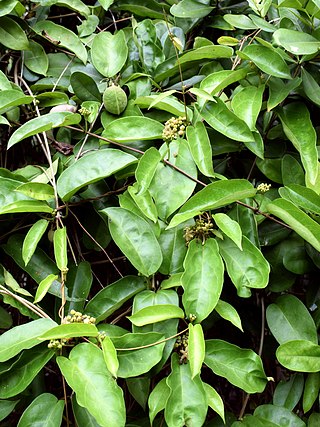
Sarcolobus is a plant genus in the family Apocynaceae, first established as a genus in 1809. It is native from Bangladesh through Southeast Asia, to New Guinea, Australia, and certain islands of the Western Pacific.

Leichhardtia flavescens, synonym Marsdenia flavescens, is a vine found in eastern Australia. Common names include hairy milk vine, yellow milk vine and native potato.
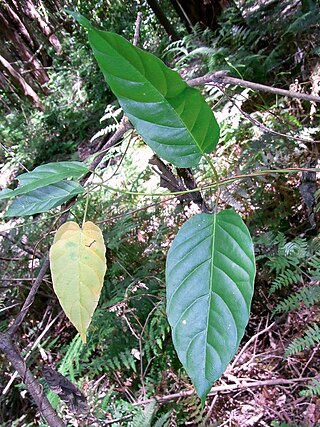
Leichhardtia rostrata, synonym Marsdenia rostrata, is a common climbing plant found in eastern Australia. This member of the dogbane family features white milky sap, when leaves are broken from the stem. It is found in a variety of habitats in relatively high rainfall areas, including rainforest and wet eucalyptus forest. Widespread in distribution in coastal regions, though it also appears inland in places such as the Liverpool Range. It may grow to ten metres tall, with a woody stem up to 4 cm wide. Leaves range from 4 to 13 cm long and 2 to 7 cm wide. The fruit is somewhat pear shaped, 5 cm by 2.5 cm.
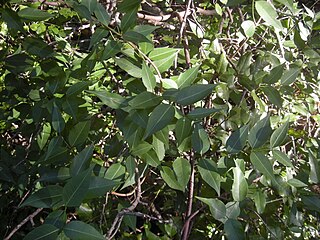
Gymnanthera is a genus of vines in the family Apocynaceae, first described as a genus in 1810. It is native to China, Southeast Asia, and Australia.
- Gymnanthera cunninghamii(Benth.) P.I.Forst. - Enderby Island + Dampier Archipelago of Western Australia
- Gymnanthera oblonga(Burm.f.) P.S.Green - S China, Cambodia, Indonesia, Malaysia, New Guinea, Philippines, Thailand, Vietnam; Australia
Leichhardtia tubulosa is a species of plant of unknown habit in the dogbane family, first described by Ferdinand von Mueller in 1875 as Marsdenia tubulosa. It is endemic to Australia's subtropical Lord Howe Island in the Tasman Sea. It is known only from a single collection, made in 1871 on the summit of Mount Gower, and is believed to be extinct.

Mischarytera is a genus of rainforest trees, constituting part of the plant family Sapindaceae. Four species are known to science as of December 2013, found growing naturally in eastern Queensland, Australia, and in New Guinea. Formerly until 1995, they had names within the genus Arytera, subgenus Mischarytera.

Leichhardtia lloydii, synonym Marsdenia lloydii, is a climbing plant found in eastern Australia. It is known as the corky marsdenia. This member of the dogbane family exudes white sap when leaves are broken from the stem. The stems have a white fissured corky covering. This plant is found in and around drier rainforest areas, north from Gloucester, New South Wales.
Paul Irwin Forster is an Australian botanist. He obtained his doctorate from the University of Queensland in 2004 with his thesis The pursuit of plants : studies on the systematics, ecology and chemistry of the vascular flora of Australia and related regions.
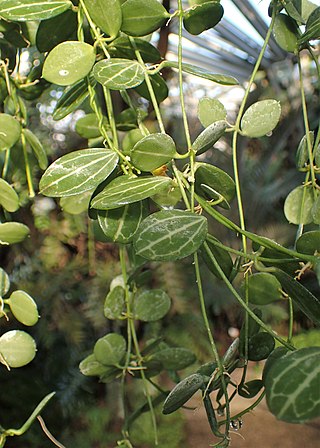
Dischidia ovata, commonly called watermelon dischidia, is a small vine in the frangipani and hoya family Apocynaceae, native to New Guinea and Cape York Peninsula, Australia. The species name ovata refers to its ovate leaves, its common name refers to the leaf venation that resembles a watermelon rind. The species is succulent and grows as an epiphytic or lithophytic vine in a variety of habitats.

Leichhardtia is a genus of flowering plants in the dogbane family (Apocynaceae). It includes 85 species native to mainland Australia, Papuasia, New Caledonia, and Lord Howe Island.
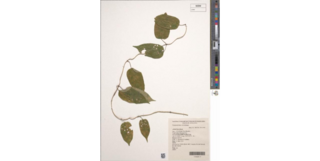
Leichhardtia liisae is a climbing plant in the Apocynaceae family, endemic to north-eastern New South Wales.

















